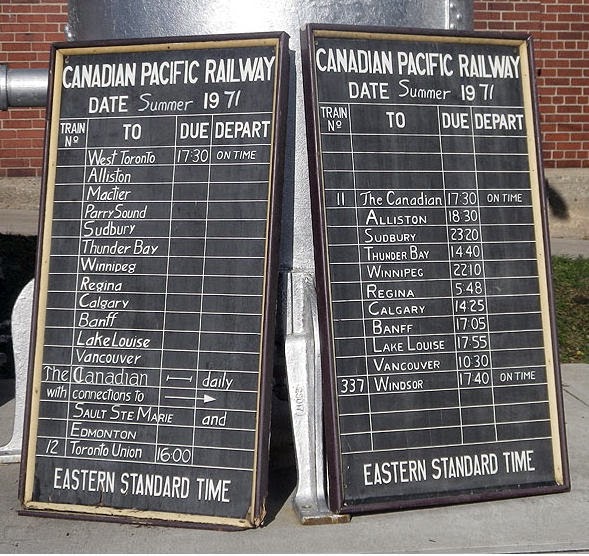Acquisition of the West Toronto Schedule Boards – Part 1 of 2
 |
| The West Toronto schedule boards outside the rear entrance to the museum, December 2014. |
Recently the Toronto Railway Museum acquired several significant artifacts to add to our growing collection. These include the Canadian Pacific Railway West Toronto schedule boards that hung on the side of the station until 1971. Wooden train schedule boards mounted on the exterior walls were a feature of all smaller railway stations and provided passengers with pertinent information about the trains that stopped there, especially when the station was closed and there was no agent on duty. These new acquisitions compliment the Agincourt schedule board frequently mounted outside Don Station during the summer months.
As the name indicates, West Toronto was the second CPR station west of Union Station. A station was first established at this location when the railway entered the city in 1884. The area has had many official names: first as the village of Carlton, then West Toronto Junction, then Toronto Junction and finally, West Toronto, though most Torontonians refer to the district simply as “The Junction.” Three Canadian Pacific and two Canadian National subdivisions intersected here in a series of diamond crossings.
Until 1892, all CPR passenger trains entering Toronto from any direction came through West Toronto, including trains from Montreal and Ottawa. This was not an efficient way to run a railway since it added a half hour onto the journey and the CPR sought direct access into downtown Toronto from the east. Finally, in 1892, they opened a branch from Leaside down the Don Valley, past Don Station, and west into Union Station, eliminating awkward train movements and considerably speeding up travel time.
In 1911, the CPR built a new West Toronto passenger station, an attractive structure in the mock-Tudor style then fashionable for important but suburban depots. The building was located on Weston Road near Dupont and Dundas West. The railway also built two roundhouses, important locomotive shops and their principal freight yards in the West Toronto/Lambton vicinity.
By the early 1920’s, there were up to 40 trains a day stopping at West Toronto, including the Trans-Canada Limited, for which Cape Race was built in 1929. As steam gave way to diesel-electric locomotives during the 1950’s, West Toronto station remained a busy place with as many as 25 daily passenger trains calling there in 1955. From that point on, the number of trains significantly dwindled. The Toronto-Vancouver “Canadian” continued to stop at West Toronto until it was taken over by VIA Rail in 1978.
Unsuccessful efforts were made to preserve the station but it was demolished by CP in 1982, much to the chagrin of the City of Toronto. Some claim that the railway’s decision to donate the John Street Roundhouse to the City of Toronto was partly motivated by a desire to make amends with the city following the illegal demolition of the station in order to advance CP’s plans to redevelop the downtown Railway Lands.
Click here to read part 2 of this series of TRHA News postings
Posting by Derek Boles, TRHA Historian
Click on each image for a closer look!
 |
| An early postcard view of West Toronto station, probably dating from around World War I. The wooden trainboards are visible underneath the semaphore on either side of the bay windows. |
 |
| A clear view of the two boards from the station platform. There appears to be nine trains on each board, which would date them circa 1960. |



